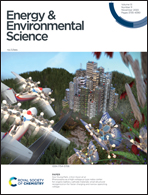Towards more environmentally and socially responsible batteries†
Abstract
While rechargeable batteries are critical for fighting the climate crisis, they are not free of environmental and social impacts. Here, we provide a robust, holistic, and accessible framework for researchers to use to assess these impacts for any battery material. The framework addresses four key issues present during the battery manufacturing process: (i) total energy use and emissions, (ii) toxicity, (iii) habitat destruction, and (iv) social impact. This article also includes example impact assessments for three battery chemistries that are being intensely pursued for current and future energy storage applications: (i) LiNi0.8Mn0.1Co0.1O2 (NMC811)-graphite, (ii) LiFePO4 (LFP)-graphite, and (iii) aqueous Na-ion. Based on the results of these assessments, we offer the following recommendations for making batteries more environmentally and socially responsible. First, given the human rights issues related to its extraction, cobalt usage must be eliminated entirely. To reduce energy use and emissions, the N-methylpyrrolidone (NMP) solvent should be eliminated. To reduce battery toxicity significantly, low toxicity electrolyte salts and non-toxic binders should be used. Iron and manganese-based cathodes are less toxic, less energy-intensive alternatives to cobalt and nickel-based cathodes. Lastly, to preserve habitat, sodium should be used over lithium for grid storage and cellulose separators over polyethylene separators for all applications.



 Please wait while we load your content...
Please wait while we load your content...